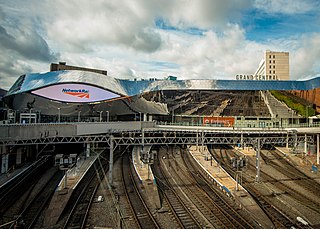
Birmingham New Street, also known as New Street station, is the largest and busiest of the three main railway stations in Birmingham city centre, England, and a central hub of the British railway system. It is a major destination for Avanti West Coast services from London Euston, Preston, Glasgow Central and Edinburgh Waverley via the West Coast Main Line, the CrossCountry network, and for local and suburban services within the West Midlands; this includes those on the Cross-City Line between Lichfield Trent Valley, Redditch and Bromsgrove, and the Chase Line to Walsall and Rugeley Trent Valley. The three-letter station code is BHM.
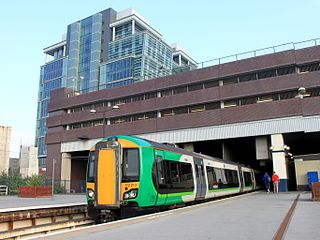
Birmingham Snow Hill, also known as Snow Hill station, is a railway station in Birmingham City Centre. It is one of the three main city-centre stations in Birmingham, along with Birmingham New Street and Birmingham Moor Street.

The West Midlands Metro is a light-rail/tram system in the county of West Midlands, England. The network has 33 stops with a total of 14 miles (23 km) of track; it currently consists of a single route, Line 1, which operates between the cities of Birmingham and Wolverhampton via the towns of Bilston, West Bromwich and Wednesbury, on a mixture of former railway lines and urban on-street running. The system is owned by the public body Transport for West Midlands, and operated by Midland Metro Limited, a company wholly owned by the West Midlands Combined Authority.

Transport for West Midlands (TfWM) is the public body responsible for co-ordinating transport services in the West Midlands metropolitan county in England. It is an executive body of the West Midlands Combined Authority (WMCA), with bus franchising and highway management powers similar to Transport for London. TfWM's policies and strategy are set by the Transport Delivery Committee of the WMCA.
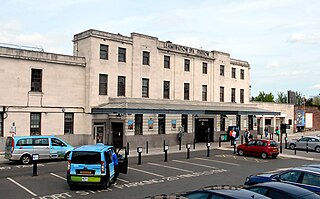
Leamington Spa railway station serves the town of Leamington Spa, in Warwickshire, England. It is situated on Old Warwick Road towards the southern edge of the town centre. It is a major stop on the Chiltern Main Line between London and Birmingham, and is the southern terminus of a branch line to Coventry.

University railway station serves the University of Birmingham, Birmingham Women's Hospital, and the Queen Elizabeth Hospital in the West Midlands of England. It is on the Cross-City Line, which runs from Redditch and Bromsgrove to Lichfield via Birmingham New Street. Most services are operated by West Midlands Railway who manage the station, but some are operated by CrossCountry.

Birmingham Moor Street, also known as Moor Street station, is one of three main railway stations in the city centre of Birmingham, England, along with Birmingham New Street and Birmingham Snow Hill.

Smethwick Galton Bridge is a split-level railway station in Smethwick, West Midlands, England. It is at a point where two railways' lines cross on two levels. It has platforms on both lines, allowing interchange between them. The two low-level platforms serve the Birmingham New Street to Wolverhampton Line, while the two high-level platforms serve the Birmingham Snow Hill to Worcester Line. The high level line passes over the low level line at a right angle on a bridge. West Midlands Railway manages the station and operates most of its services, with others provided by Chiltern Railways and London Northwestern Railway.

The Birmingham to Worcester via Kidderminster line is a railway line which runs from Birmingham Snow Hill to Worcester via Stourbridge and Kidderminster in the West Midlands, England. It is one of the Snow Hill Lines, with trains operated by West Midlands Trains and Chiltern Railways using a variety of rolling stock including Class 172 and Class 168 diesel units. It is a future aspiration of Network Rail to electrify the entire line, as well as the Chiltern Main Line to London Marylebone.

Solihull railway station serves the market town of Solihull in the West Midlands of England. The station is served by West Midlands Trains and Chiltern Railways. CrossCountry serve the station occasionally to replace stops at Coventry and Birmingham International during engineering work. Solihull used to have a regular Virgin CrossCountry service to Manchester Piccadilly, Blackpool North and Portsmouth Harbour until 2004, when all services through the station were made to run non-stop between Birmingham and Leamington Spa.
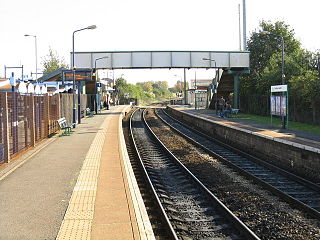
Cradley Heath railway station serves the town of Cradley Heath in the West Midlands of England. It is on the Birmingham to Worcester via Kidderminster line. The station is managed by West Midlands Railway, who provide the majority of train services; there are also occasional services provided by Chiltern Railways.

Coleshill Parkway is a railway station at Hams Hall on the Birmingham to Peterborough railway line, serving Coleshill in Warwickshire, England. Sitting on the site of the former Coleshill station which closed in 1968, the current station was opened in 2007. Unusually it is not owned by Network Rail. It is managed by West Midlands Trains train operating company (TOC) although all rail services are operated by CrossCountry.

The transport infrastructure of Greater Manchester is built up of numerous transport modes and forms an integral part of the structure of Greater Manchester and North West England – the most populated region outside of South East England which had approximately 301 million annual passenger journeys using either buses, planes, trains or trams in 2014. Its position as a national city of commerce, education and cultural importance means the city has one of the largest and most thorough transport infrastructures which is heavily relied upon by its 2.8 million inhabitants in the Greater Manchester conurbation and further afield in the North West region. Public transport comes under the jurisdiction of Transport for Greater Manchester.
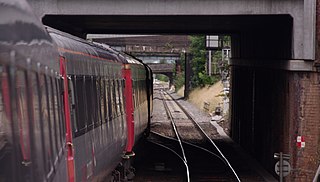
The Camp Hill line is a railway line in Birmingham between Kings Norton on the Cross-City Line and Birmingham New Street via Grand Junction on the main lines from Derby and Coventry. The line was once the terminal approach of the Birmingham and Gloucester Railway to Curzon Street before it was incorporated into the Midland Railway.

The Snow Hill Lines is the collective name for the railway lines running through Birmingham Snow Hill, and Birmingham Moor Street stations in Birmingham, United Kingdom. They form an important part of the suburban rail network of Birmingham, Warwickshire and Worcestershire. All other lines to/through Birmingham use Birmingham New Street station. The Snow Hill lines carry around 20% of the daily rail services into Birmingham; the remainder use New Street.
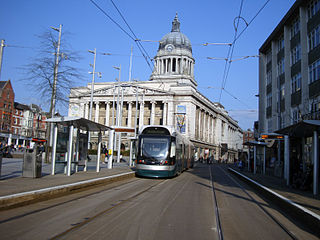
Nottingham is the seventh largest conurbation in the United Kingdom; despite this, the city's transport system was deemed to be poor for its size in the 1980s. In the early twenty-first century, the UK government invested heavily in the transport network of Nottingham, which has led to the re-opening of the Robin Hood Line and the construction of a light rail system, Nottingham Express Transit.

Urban andsuburban rail plays a key role in public transport in many of the major cities of the United Kingdom. Urban rail refers to the train service between city centres and suburbs or nearby towns that acts as a main mode of transport for travellers on a daily basis. They consist of several railway lines connecting city centre stations of major cities to suburbs and surrounding towns.
Liverpool in North West England, is a major British city with significant road, rail, and ferry networks, in addition to an international airport and a well-known dock system. As with most other major UK cities, Liverpool's transport infrastructure is centred on its road and rail networks. Public transport services within the city are controlled and run by Merseytravel.

The West Midlands Passenger Transport Executive (WMPTE) was the public body responsible for public transport in the West Midlands metropolitan county in the United Kingdom from 1969 until 2016. The organisation operated under the name Centro from 1990, and was publicly branded as Network West Midlands from 2005.

The Birmingham station group is a station group of three railway stations in Birmingham city centre, consisting of New Street, Moor Street, and Snow Hill. The station group is printed on national railway tickets as BIRMINGHAM STNS and does not include the international station of Birmingham International, which is located some 14 kilometres (8.7 mi) east of the city centre next to Birmingham Airport and National Exhibition Centre.

































